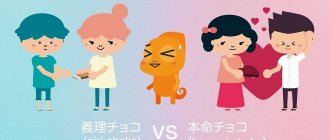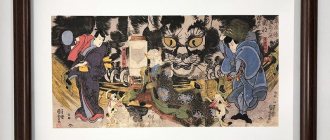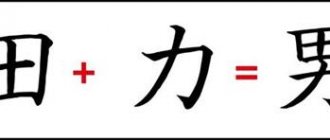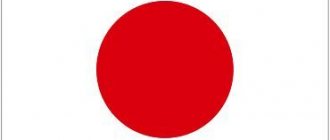How to spell cat in Japanese
Useful information:
You can display the last few kanji or words
Loading the module Random hieroglyph.
Wait for the module to load, or click the “Update Now” button
We write in Japanese. Katakana ABC
The proposed manual is a workbook for.
We write in Japanese. Hiragana alphabet
The proposed manual is a workbook for.
Preparing for the qualifying exam.
We present to your attention a book to prepare for.
Collection of exercises to prepare for the quarter.
This publication presents a collection of exercises for.
Let's learn kanji. Part 2
We present to your attention the second part of the book “Learning.
Source of the article: https://www.nihongo.aikidoka.ru/kanji_844.html
"Dog"
The character 犬 entirely represents one element , as you might guess, “dog”. It is also key number 94 , which we know from the previous sign.
Him:ケン
Kun:いぬ – dog
This hieroglyph is pictographic . Its ancient form depicts a dog standing on its hind legs. Of course, now this silhouette is difficult to read due to the fact that the outline of the hieroglyph has transformed over time.
| Word | Reading | Translation |
| 犬歯 | けんし | fang |
| 愛犬 | あいけん | favorite dog |
| 野犬 | やけん | homeless dog |
| 小犬 | こいぬ | puppy |
Japanese language and cats
The Japanese are truly cat lovers. In Japanese you can even find common expressions related to cats. Let me give the following three as examples:
1) So busy that he wouldn’t refuse a paw of help from a cat - Neko no te-mo karitai hodo isogashii (猫の手も借りたいほど忙しい)
2) Small, like a cat’s forehead – Neko no hitai no yo: na (猫の額のような)
3) Giving a cat a koban (such an old coin), in the sense of “throwing pearls before swine” - Neko-ni koban (猫に小判)
No duplicates found
Based on these phraseological units, it doesn’t seem like they love him)) Useless in terms of help (people are ready to go to the cat last, as we see), with a small forehead, dull (like that pig with beads), and also a stooped animal.
猫をかぶる (neko wo kaburu) like pretending to be a good boy 借りてきた猫 (karitekita neko) like when you are nervous, worried, or quiet in a new place or when meeting new people
猫なで声 (neko nade goe) type of sucking voice
buddy, tell me not about service, but about friendship
How to write hiro-katoi-kanji on a standard keyboard?
what needs to be installed in addition to the additional language in Windows (ofk already done)
ok, that was easy
but how to write? what is the layout and how to use it?
I don’t know about you, I just added the language
Writing with this layout is not that difficult, but you need to know the words.
Switch to Japanese, in place of the language there will be a black and white letter J
There should be a あ icon to the left of it, but if it is not there, right-click on what is there and select the “Hiragana” option
Next, simply type the word in Latin (in the same language) and press space, you will get a list of options for which hieroglyph/alphabet to use in this case
And the last phrase is definitely not from Hochland? ))) neko ne boar, will you come to some sense, mykola?
"Wolf"
In the hieroglyph 狼, two components : on the left is “dog” 犭, which we already know, and on the right is 良 “good”. As you might have already guessed, “dog” is the key of this sign at number 94 .
Him:ロウ
Kun:おおかみ – wolf
The origin of this hieroglyph is simple: the left element “dog” is responsible for its meaning , symbolizing an animal related to dogs, and the right element is a phonetician . If you look at the meaning of individual components, you get an absurd but funny mnemonic rule : “wolf” 狼 is “good” 良 “dog” 犭.
| Word | Reading | Translation |
| 虎狼 | ころう | tiger and wolf; beasts of prey; arr. Cruel person |
| 天狼星 | てんろうせい | Sirius (star in the constellation Canis Major) |
| 狼狽 | ろうばい | confusion, confusion; confusion, panic |
| 狼藉 | ろうぜき | disorder, confusion; riot, outrage, debauchery |
Our article has now come to an end. We hope you found it useful. For those who missed the previous material on hieroglyphics, we leave links to it:
Japanese characters: "demon", "snake", "evil", "hatred"
Japanese characters: “smile”, “kindness”, “emptiness”, “loneliness”
Japanese characters: “heart”, “hope”, “loyalty”, “faith”
Japanese characters: “moon”, “star”, “sea”, “noise”
Japanese characters: "tea", "sakura", "art", "money"
Japanese characters: “perfection”, “infinity”
Japanese characters: "peace", "tranquility", "harmony"
Japanese characters: "day", "night", "light", "darkness"
Japanese characters: “horse”, “fox”, “elephant”
Japanese characters: "man", "woman", "child", "children", "school"
Good luck in learning Japanese!
Japanese characters: “cat”, “cat”, “dog”, “tiger”, “wolf” - we analyze the readings, spellings and meanings in this article. Let's learn Japanese kanji together on our website!
The guy enjoyed strange Japanese food for two months and only then found out.
A Reddit user with the nickname SNIHON talked about how he found out that the food he liked was intended for. cats.
The guy was looking for some kind of snack in the grocery store and came across something that resembled rice crackers. “My Japanese was terrible back then, so I used a translator in stores,” the narrator recalled. The label depicted cheese with fish - the user thought that this was probably a special Japanese taste.
“I translated the name - it turned out something like “healthy cheese.” Nothing at all about cats. I bought. And I liked it! A few days later I returned to the store and took a couple more packs,” said SNIHON. The secret was revealed when he went to the cinema with his Japanese friend and invited her to try a snack. "She looked at the pack and said, 'Do you have a cat?' But I didn’t. Then she started explaining that my favorite snack is actually a cat snack,” the user described.
This information surprised the user. His girlfriend laughed and then tried the food and agreed - the snack was really tasty. “She also told me that I might get sick if I continue using it,” SNIHON said. However, he gave up the snack only when he found an alternative among people's food.
Source of the article: https://pikabu.ru/story/yaponskiy_yazyik_i_kotiki_4624376
List of Japanese names in alphabetical order
How to name a boy's Scottish kitten: the best nickname options
Regardless of what gender the kitten is, you can choose a nickname for each animal, the meaning of which will correspond to the individual characteristics of your four-legged friend. First, it’s worth looking at Japanese names for cats.
Note! Many owners of furry beauties wonder what the Japanese word for cat is. After all, if difficulties arise with choosing a specific nickname for a pet, you can call it a name that is consonant with the translation of the word “cat”. A cat in Japanese will sound like “neko” - a very interesting nickname for a pet. By the way, a cat in Japanese has the same translation, so males can also be called “neko”.
For girls
The list below contains unusual beautiful names for domestic cats.
- Aoi means “blue”, so it’s perfect for blue-eyed cats.
- Asami is a nickname meaning “morning beauty.” Best suited for picky pets who carefully care for their fur.
- Ayumi translates to “to make progress.” Cats that are active and show interest in the world around them will be grateful to their owner for this nickname.
- Eiko is the “eternal child.” An eternally young cat that never grows up, never losing its enthusiasm and childish spontaneity.
- Kimiko is the name given to “queens or mistresses.” An ideal name for cats who love to be pampered and cannot tolerate their whims being ignored.
There are plenty of options for girls
- Masako - "elegance". Characterizes elegant animals. The nickname is perfect for those with royal manners and graceful posture.
- Mi. This nickname is suitable for self-confident, calm cats who always have an impeccable appearance.
- Miwa is suitable for a calm cat who prefers to rest on the windowsill near the window or on the owner’s lap.
- Rey characterizes the animals as having a "free spirit." Perfect for fearless pets who are always ready for active play. Cats endowed with this name have inexhaustible energy, which constantly pushes them to find new adventures.
- Yuna is suitable for gentle and calm cats. Affectionate owners of this name are not shy even about strangers and show warm feelings towards them.
For boys
This list contains Japanese cat names, each with its own unique meaning.
- Aki - “bright” or “autumn”. Great for brown and tabby cats with shiny coats. This name can also be used to call cats.
- Akihiko is a Japanese nickname for smart and graceful cats that have royal demeanors and are like princes.
- Akira translated into Russian means “bright”. If a smart pet loves to explore its environment, learns quickly, and has a very studious nature, this is the name for it.
You can also choose an interesting Japanese nickname for boy cats
- Arata - "new". This is what long-awaited kittens are usually called. A symbol of change and the joy that owners experience when a pet appears.
- Michio is suitable for adventurous traveling cats. Eternally curious pets who actively spend their free time deserve to be called that way.
- Nori is a “born ruler.” A nickname for leading and leading cats.
- Satoshi - “grabbing on the fly, wise.” Suitable for smart cats who learn quickly, while behaving calmly and reservedly.
- Yoshio is a nickname for funny cats. Characterizes funny, optimistic animals who cannot get enough of life.
Legends of origin
The Japanese cat appears in several mythical stories. The legends of the Gotokuji, Imado, and Fushimi Inari temples are most often told. The first two are located in the current capital of the country, the third is in the former capital (Kyoto).
Priest cat
This story about the Japanese lucky cat Maneki-neko is the most famous. The legend dates back to Edo times and is associated with the temple complex at Setagaya. This temple was once loved by people, but then fell into disrepair. Ii Naotaka, who ruled the Hikone clan, passed by an abandoned sacred place after a hunt and saw a temple cat. The animal's paws beckoned the daimyo and his entourage to visit the house. This seemed strange to the ruler, so he went inside the temple. The daimyo was tired, the place seemed great for rest. Almost immediately a storm broke out, hurricane winds and incredible rain washed out the road. While inside, the daimyo realized that the cat had saved him from the weather. Imbued with gratitude, he donated the money spent on reconstruction to the temple, and the image of the pet itself turned into a happy sign.
Legends about the symbol are associated with the Edo period
The meaning of the Maneki-neko symbol has a second interpretation, also associated with the history of Naotaka. The daimyo was not far from the dilapidated temple when the storm began. He tried to hide under the trees, but suddenly saw a cat, as if inviting him with its paws. Naotaka approached the animal, at that moment lightning burned to the ground the tree under which he was hiding a minute ago. The daimyo realized that he had miraculously escaped death - he was saved by the temple cat. In gratitude for the good fortune, the ruler gave the holy place a generous donation, which made it possible to restore the structure and give it its current appearance.
Courtesan cat
Usugumo is a tayu whose history is preserved in Japanese myths. Her happiness lay in cats. Next to the woman there were always faithful companions - her pets. One day, in the dark, the courtesan was about to leave the house, but her beloved animal clung to her clothes, preventing the woman. A guard came to the sound and cut off the pet’s head, which flew to the ceiling and grabbed the snake that was threatening its owner with its teeth. With its last breath, the animal saved the woman and destroyed the dangerous reptile. The courtesan was sad about her lost pet and one day received as a gift from a guest a figurine depicting her favorite. She became her personal talisman. Soon others wanted one for themselves. So the figurine gradually spread throughout the country.
According to legend, the cat saved its owner from a snake
The story of the cat from Imado
This legend comes from the Edo period. In the west of the modern capital there lived an old woman, Imado. She led a miserable existence. All her life she had her beloved cat, but the old woman became so poor that she could not feed herself or her pet. She decided to drive the animal away so that it could survive on its own. Soon, her pet appeared to her in a dream, demanding that she make a figurine of a cat out of clay and place it at the door. The old woman obeyed. A little time passed and a passer-by, taking a closer look at the figurine, purchased it for himself. The woman realized that this could generate income and made several cats. Things went well and she became rich. Her pet returned home, the old woman lived with her for many more years in comfort and satiety.
Stories about a cat - stories of luck and success
Theory about the symbolic meaning of Maneki-neko
Mystics are sure that Maneki-neko is a deity who appears to people in the form of a cat beckoning with its paw. All legends show that higher powers favor people and help when no other help can be expected. If a cat invites, it is wise to follow him - this is a sign given by higher powers. It portends good things, foretells good luck.
Nowadays, rooms on the 3rd floor are often decorated with a figurine, since the number 3 in Japanese mythology is associated with good omens.
Name for cats from popular Japanese anime
All fans of cartoons can choose anime nicknames for cats; pets are often named after their favorite hero. Characters have certain traits and abilities. Perhaps your tailed one also has a special gift?
- Ichigo (m)
- Rukia (w)
- Hichigo (m)
- Orihime (w)
- Yasutora (m)
- Kisuke (m)
- Jushiro (m)
- Nemu (w)
- Kenpachi (m)
- Kusadzisi (w)
- Aizen (m)
- Momo (w)
- Soi Fon (w)
- Luffy (m)
- Sanji (m)
- Nico Robin (w)
- Naruto Uzamaki (m)
- Kakashi Hatake (m)
- Choumei
- Gyuki
- Saiken
- Matatabi
- Deidara (m)
- Tenten (w)
- Sasori (m)
- Hinata (w)
- Inuzuka Kiba (m)
- Haku (m)
- Zabuza Momochi (m)
- Yamato (m)
- Shikamaru (m)
Charlie from Fairy Tail
- Uchiha Madara (m)
- Conan (w)
- Gaara (m)
- Mei (w)
- Might Guy (m)
- Nagato (m)
- Evergreen (w)
- Kildurst Clive (m)
- Lisanna Strauss (w)
- Elfman (m)
- Charlie
- Happy
- Mirajane (w)
- Glitcheye (m)
- Lucy (w)
- Elsa Scarlett
- Gajeel Redfox
- Juvia (w)
- Loki (m)
- Igneel
- Minerva (w)
- Zeref (m)
- Freed Justin (m)
- Cana Alberona (w)
- Wendy Marvel (w)
- Kirito (m)
- Asuna (w)
- Zaza (m)
- Lisbeth (f)
- Konno Yuki (w)
- Silica (w)
- Quinella (w)
Happy from Fairy Tail
- Kradil (m)
- Alicia (w)
- Nori (w)
- Argo (m)
- Keita (m)
- Eugeo (m)
- Kirigaya Midori (w)
- Recon (m)
- Koper (m)
- Kibao (m)
- Godfrey (m)
- Solterina (w)
- Diabel (m)
- Skuld (w)
- Endo (w)
- Sailor Moon – Tsukino Usagi (w)
- Sailor Mars – Hino Ray
- Sailor Baby – Usagi, Chibi-Moon
- Chiba Mamoru (m)
- Sailor Venus – Aina Minakopro
Previous Post Nicknames |
Names for white cats with meaning | The mystery of the name Next entry Cartoon nicknames | names for cartoon cats
Maneki Neko - Japanese symbol of happiness
Maneki Neko are images of cute cats with their paws raised. There are many good luck talismans in Japan, Maneki Neko is one of the most popular. This talisman has many names - “inviting cat”, “calling cat”, “money cat”. But they all have one common meaning - good luck will definitely settle in your home. If we translate the expression “maneki-neko” literally from Japanese, it means “beckoning cat.”
At first glance, I was fascinated by these cat figures with some spontaneity and touching, they radiate kindness, warmth and warm the soul. Figurines are placed at home or in the office, in a store or pub to attract good luck, wealth, friends, assistants, associates, clients, customers; they can be made of a variety of materials: clay, porcelain, wood, jade, silver, gold. A raised paw and a collar with a bell are a must-have for alluring cats. It is believed that the first domestic cats came to Japan in the 6th century thanks to a Buddhist monk who was tasked with bringing ancient manuscripts. Trying to bring the sacred scriptures safe and sound, the monk took a domestic cat on the sea voyage from China to Japan to protect the manuscripts from rats. The cat fulfilled its duty and remained in Japan. Due to the small number (and therefore high cost) of cats, only wealthy people could afford to keep them at home. Collars were made for the cats and a bell was hung so that they would not get lost.
Cats were also kept at Buddhist temples, they were carefully protected and kept on a special leash. The duty of cats was to catch mice, and this is what made it possible to preserve the most valuable ancient Buddhist manuscripts to this day. There are several legends about the origin of the Maneki Neko symbol; the stories contain images of a wealthy gentleman or a poor woman and even a courtesan, but the main character is a cat. The first mentions of Maneki-Neko appeared at the beginning of the 17th century.
Antique Maneki Neko
Maneki Neko images can have the right, left, or both legs raised at the same time. Maneki Neko with her left paw raised has the ability to attract good luck, wealth, happiness and love. Raised right paw - to wealth. Cats with two raised paws to attract buyers and guests, and to “lure” monetary luck and happiness. According to legend, the higher the cat's paw is raised, the faster the wish will come true.
The colors of Maneko Neko can be different and each has its own meaning. The most popular among the Japanese is the tricolor (white with spots) Maneki Neko. It is believed that the tricolor cat is the happiest talisman, personifying a happy and comfortable life. There are also white, gold, black, green, red and pink Maneki Neko.
Cat figures can be with open or closed eyes. Closed eyes symbolize receiving desired benefits in the near future, while open eyes symbolize the fulfillment of desires in the future. In addition, Maneki Neko has different additions: a red or multi-colored collar, and a bell or coin on the collar. You can often see cats holding a Koban (Edo era gold coin) worth 10 million ryu in their paw, which allows the cat to claim the role of an effective money amulet. Sometimes Maneki Neko wears a red bib - this is a sign of patronage for children and pregnant women. In its paws, a cat can hold a coin, a carp, a scroll with hieroglyphs and other talismans that enhance the energy of the cat symbol. Some Maneki Neko figurines hold sea bream in their paws, which is a symbol of long life.
In 1994, the Maneki-Neko Museum opened in Okayama. The museum has a huge collection of “cats that bring good luck.”
In the capital of Japan, Tokyo, there is a temple dedicated to Maneko Neko.
My acquaintance with this wonderful Japanese talisman once inspired me to create one of the first works using an unusual technique. I wanted to make Maneki Neko in an unconventional material!
I hope that the publication will be useful to you and will give you new ideas in creative work and interior design of your home or office. Images of cute and charming cats, it seems to me, cannot leave anyone indifferent!
All materials are taken from free access on the Internet.
Best regards, Lana.










